This page is updated as books are received throughout the month.
 Seed by Ania Ahlborn
Seed by Ania Ahlborn
47North, $14.95, 250pp, tp, 9781612183664. Horror. On-sale date: July 2012.
I’ve always been here, and I’ll never leave. That’s the mocking promise of a relentless monster that, decades before, took hold of a boy—body and soul—and swore to hang on like hell. But young Jack Winter cut and ran, leaving his parents and the only life he knew. Falling in love, raising a family, and making music were just what he needed to bury the hideous past—like the unknown dead in that hidden Louisiana bayou cemetery where his nightmare began.
Now, twenty years later, Jack and his family will discover that surviving a harrowing car crash wasn’t a blessing, but the prelude to a new reign of terror by an old friend who’s back in town with time to kill.
In the spine-tingling tradition of Stephen King comes this generation’s new voice in horror.
 Spellcrossed by Barbara Ashford
Spellcrossed by Barbara Ashford
DAW, $7.99, 435pp, pb, 9780756407292. Fantasy.
<>i>It’s not easy losing the magic in your life…
But when Maggie Graham freed Rowan Mackenzie to return to Faerie, she took the first step toward her new life as director of the Crossroads Theatre.
A hectic new season of summer stock leaves her little time to moon over the past. She has to balance the demands of her interfering board president and a company of actors that includes bewildered amateurs, disdainful professionals, a horde of children, and an arthritic dog. And while Maggie yearns to give others the kind of healing she found at the Crossroads, even she recognizes that magic must take a back seat to ticket sales.
But magic is hard to banish from the old white barn. Memories lurk like ghosts in the shadowy wings and the unexpected is as time-honored a tradition as the curtain call. And when the tangled spells of Maggie’ past turn her life upside down, it will take more than faery magic to ensure the happy-ever-after ending she longs for.…
 The Janus Affair: A Ministry of Peculiar Occurrences Novel by Pip Ballantine & Tee Morris
The Janus Affair: A Ministry of Peculiar Occurrences Novel by Pip Ballantine & Tee Morris
Harper Voyager, $7.99, 416pp, pb, 9780062049780. Fiction.
Book two in this Edwardian steampunk adventure series, featuring two secret agents from the “Ministry of Peculiar Occurrences.”
There’s something rotten in the city of London. Women are disappearing—young and old, rich and poor, from all walks of society. The only thing they have in common is their belief that women also deserve the vote.
It’s up to the Ministry of Peculiar Occurrences to find out why these women are vanishing, but agents Brooks and Braun have their own challenges. There’s a turncoat with nefarious plans within the Ministry itself, and the reappearance of an old flame means their growing friendship is threatened.
To say nothing of the queen of the underworld, assassins-attacking-on-ornithopters, and a conspiracy that reaches to the heights of London Society.
 Marksmen Volume 1 story by David Baxter & Dave Elliott
Marksmen Volume 1 story by David Baxter & Dave Elliott
Image Comics, $15.99, 192pp, tp, 9781607064862. Action/SciFi Graphic Novel.
Sixty years ago the oil ran out and debts were called in. Civil war followed that splintered America into warring fiefdoms. New San Diego is a technocratic utopia that offers the last bastion of peace and prosperity, provided you live within its walls. Drake McCoy is its best protector. One of a select group of Marksmen, descended from the Navy Seals, McCoy defends the city from the numerous threats in the wasteland outside the walls. But when the oil rich Lone Star State sends a powerful army to steal New San Diego’s energy technology, even the Marksmen’s skill may not be enough to fend off the siege.
 The Wanderers by Paula Brandon
The Wanderers by Paula Brandon
Spectra, $15.00, 418pp, tp, 9780553583830. Fantasy. On-sale date: 31 July 2012.
Paula Brandon’s acclaimed fantasy trilogy comes to a triumphant conclusion in an unforgettable collision of magic, intrigue, and romance.
Time is running out. Falaste Rione is imprisoned, sentenced to death. And even though the magical balance of the Source is slipping and the fabric of reality itself has begun to tear, Jianna Belandor can think only of freeing the man she loves. But to do so, she must join a revolution she once despised—and risk reunion with a husband she has ample reason to fear.
Meanwhile, undead creatures terrorize the land, slaves of the Overmind—a relentless consciousness determined to bring everything that lives under its sway. All that stands in the way is a motley group of arcanists whose combined powers will barely suffice to restore balance to the Source. But when Jianna’s father, the Magnifico Aureste Belandor, murders one of them, the group begins to fracture under the pressures of suspicion and mutual hatred. Now humanity’s hope rests with an unexpected soul: a misanthropic hermit whose next move may turn the tide and save the world.
 Kingdom of the Serpent 3: Destroyer of Worlds by Mark Chadbourn
Kingdom of the Serpent 3: Destroyer of Worlds by Mark Chadbourn
Pyr, $17.95, 383pp, tp, 9781616146177. Fantasy.
It is the beginning of the end… The end of the axe-age, the sword-age, leading to the passing of gods and men from the universe. As all the ancient prophecies fall into place, the final battle rages, on Earth, across Faerie, and into the land of the dead. Jack Churchill, Champion of Existence, must lead the Brothers and Sisters of Dragons in a last, desperate assault on the Fortress of the Enemy, to confront the ultimate incarnation of destruction: the Burning Man. It is humanity’s only chance to avert the coming extinction. At his back is an army of gods culled from the world’s great mythologies—Greek, Norse, Chinese, Aztec, and more. But will even that be enough? Driven to the brink by betrayal, sacrifice and death, his allies fear Jack may instead bring about the very devastation he is trying to prevent…
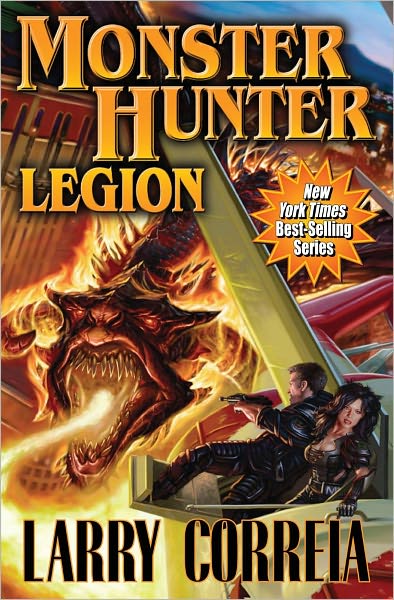 Monster Hunter Legion by Larry Correia
Monster Hunter Legion by Larry Correia
Baen, $24.00, 624pp, hc, 9781451637960. Fantasy. On-sale date: 4 September 2012.
#4 in the groundbreaking New York Times bestselling series.
Monster Hunter International might be the premier monster eradication company in the business, but they’ve got competition.
When hunters from around the world gather in Las Vegas for a conference, a creature left over from a World War Two weapons experiment wakes up and goes on a rampage across the desert. A not-so-friendly wager between the rival companies turns into a race to see who can bag the mysterious creature first.
Only there is far more to this particular case than meets the eye, and as Hunters fall prey to their worst nightmares, Owen Zastava Pitt and the staff of Monster Hunter International have to stop an ancient god from turning Sin City into a literal hell on earth.
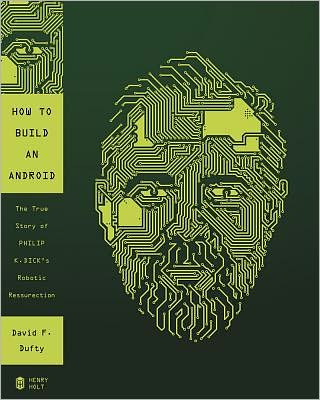 How to Build an Android: The True Story of Philip K. Dick’s Robotic Resurrection by David F. Dufty
How to Build an Android: The True Story of Philip K. Dick’s Robotic Resurrection by David F. Dufty
Henry Holt, $26.00, 288pp, hc, 9780805095517. Technology.
A young roboticist, on his way to Google headquarters, left an overnight bag on a flight between Dallas and Las Vegas. In it was the fully functional head belonging to the android replica of science fiction icon and counter culture guru Philip K. Dick. The head has never been recovered. So begins David F. Dufty’s How to Build an Android: The True Story of Philip K. Dick’s Robotic Resurrection.
How to Build an Android is the story of how sculptor David Hanson and computer programmer Andrew Olney led the visionary young team of roboticists, programmers, and artists who brought this remarkable machine to life. Made of plastic, wire, and a synthetic skin-like material called Frubber, it had a camera for eyes, a speaker for a mouth, and an elaborate artificial intelligence simulation that included Dick’s biography, novels, and short stories.
Author Dufty, who was a fellow researcher at the University of Memphis’s Institute for Intelligent Systems while the android was being built, gives us a behind-the-scenes narrative of the cutting-edge android technology and artificial intelligence that went into the project by presenting clear and entertaining explanations of the complicated scientific concepts involved.
Filled with lore about Dick himself—his inspired yet deeply pessimistic worldview, his bizarre lifestyle, and his enduring creative legacy—and tackling big questions like what separates man from machine, this book is popular science at its best.
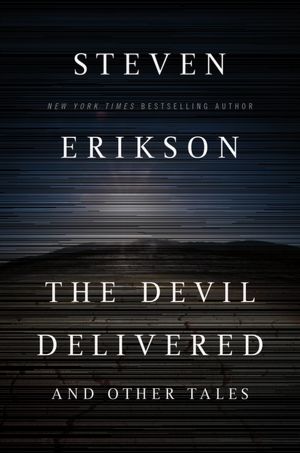 The Devil Delivered and Other Tales by Steven Erikson
The Devil Delivered and Other Tales by Steven Erikson
Tor, $27.99, 336pp, hc, 9780765330024. Fantasy.
In 2011, New York Times bestselling author Steven Erikson accomplished the rarest feat imaginable: with The Crippled God, the final novel in “The Malazan Book of the Fallen,” he actually completed a ten volume epic fantasy series. And not just any series: one of the most masterful, original and ambitious epic stories of any genre. Now Erikson returns with his first publication outside the Malazan universe: The Devil Delivered and Other Tales.
The Devil Delivered consists of four speculative novellas that Steven Erikson wrote in between novels in his Malazan series. Each story has Erikson’s familiar tone and sensibility, yet reveals another side of his prolific and compelling storytelling talent. Included in this collection are:
The Devil Delivered…
In the break-away Lakota Nation, in the heart of a land blistered beneath an ozone hole the size of the Great Plains, a lone anthropologist wanders the dead lands, recording observations that threaten to bring the world’s powers to their knees.
Past and Future…
In a world of rad-shielded cities and the unprotected populations along the edges, restless ghosts and rogue corporations face off across uneven battle lines, as the once-wide chasm between them grows ever narrower.
Revolvo…
In the fictitious country of “Canada,” the arts scene is ruled by technocrats who thrive in a secret, nepotistic society of granting agencies, bursaries, awards and peer reviews boards, all designed to permit self-proclaimed artists to survive without an audience.
Fishing with Grandma Matchie…
In this Children’s story, a boy is tasked with a writing assignment that turns into a stunning fantastical journey through a fishing trip with his eccentric Grandmother.
These four wonderfully unique offerings from the man behind the ground-breaking Malazan Book of the Fallen series will thrill the many fans of Steven Erikson’s unique and powerful speculative fiction.
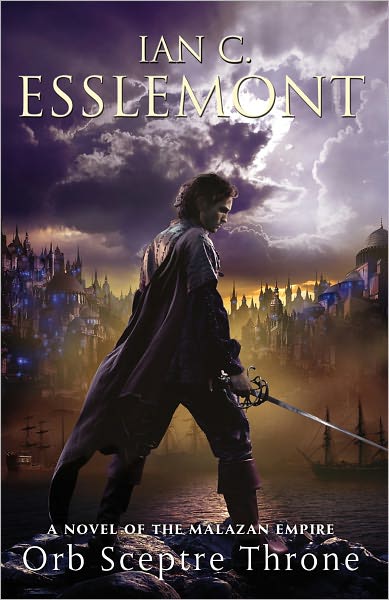 Orb Sceptre Throne by Ian C. Esslemont
Orb Sceptre Throne by Ian C. Esslemont
(a novel of the Malazan Empire), Tor, $18.99, 606pp, tp, 9780765329998. Fantasy.
Drawing comparisons to George R.R. Martin’s A Song of Ice and Fire, Steven Erikson’s A Tale of the Malazan Book of the Fallen is one of the most brutal, deep, and mercilessly-executed story’s in contemporary fantasy.
Drawn with the depth of an Archeologist’s historical scale of history, with dozens of civilizations and species and literally hundreds (if not thousands) of point-of-view characters, the Malazan universe knows no world-building rival. But many fans don’t know that it was originally a co-creation: Erikson designed it with his partner, Ian C. Esslemont, as a gaming universe seventeen years before the first novel was published. Now Esslemont continues in Erikson’s tradition by filling in the most important gaps in the history of Malaz with his third Malazan novel, Orb Sceptre Throne.
Darujhistan, city of dreams, city of blue flames, is peaceful at last: its citizens are free to return to politicking, bickering, trading, and enjoying the good things in life. Yet there are those who will not allow the past to remain buried. A Scholar digging in the plains stumbles across an ancient scaled vault. The merchant Humble Measure schemes to drive out the remaining Malazan invaders. The surviving agents of a long-lost power are stirring, for they sense change and opportunity. And a rotund thief in a red waistcoat walks the streets, in one hand juggling custard pastries, in the other the fate of the city itself…
Far to the south, fragments of the titanic Moon’s Spawn have crashed in the Rivan Sea creating a series of isles… and a fortune hunter’s dream. A Malazan veteran ventures out to try his luck—and perhaps say goodbye to old friends. He finds far more than he’d bargained for as the rush to claim the Spawn’s treasures descends in a mad scramble of chaos and bloodshed. For powers from across the world have gathered here, searching for the legendary Throne of Night.
And on an unremarkable island, a people lift their masked faces towards the mainland and recall the ancient prophecy of a return.
And what about the ex-Claw of the Malazan Empire who now walks the uttermost edge of creation? His mission—the success or failure of which the Queen of Dreams saw long ago—is destined to shape far more than anyone could have imagined.
Drawing on the events that brought Steven Erikson’s Toll the Hounds to a close, Orb Sceptre Throne is a momentous chapter in the unfolding story of the extraordinarily imagined Malazan universe.
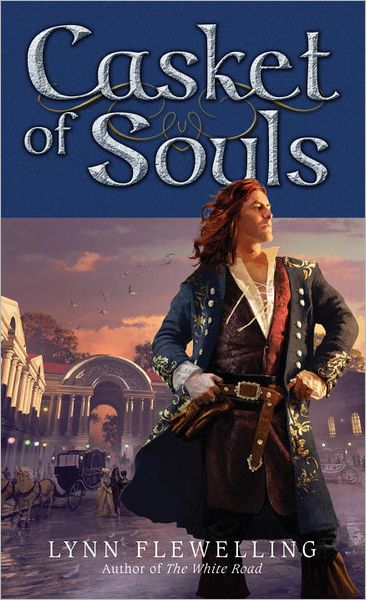 Casket of Souls by Lynn Flewelling
Casket of Souls by Lynn Flewelling
Spectra, $7.99, 476pp, pb, 9780345522306. Fantasy.
The Nightrunners are back in this gripping novel full of Lynn Flewelling’s trademark action, intrigue, and richly imagined characters.
More than the dissolute noblemen they appear to be, Alec and Seregil are skillful spies, dedicated to serving queen and country. But when they stumble across evidence of a plot pitting Queen Phoria against Princess Klia, the two Nightrunners will find their loyalties torn as never before. Even at the best of times, the royal court at Rhiminee is a serpents’ nest of intrigue, but with the wwar against Plenimar going badly, treason simmers just below the surface.
And that’s not all that poses a threat: a mysterious plague is spreading through the crowded streets of the city, striking young and old alike. Now, as panic mounts and the body count rises, hidden secrets emerge. And as Seregil and Alec are about to learn, conspiracies and plagues have one thing in common: the cure can be as deadly as the disease.
 The Presidents Club: Inside the World’s Most Exclusive Fraternity by Nancy Gibbs and Michael Duffy
The Presidents Club: Inside the World’s Most Exclusive Fraternity by Nancy Gibbs and Michael Duffy
Simon & Schuster, $32.50, 642pp, hc, 9781439127704. Nonfiction.
In The Presidents Club: Inside the World’s Most Exclusive Fraternity, two top journalists and bestselling authors present a fascinating, news-making account of the personal and political relationships among America’s modern presidents as well as a new lens through which to view both American history and the presidency itself. Time magazine editors Nancy Gibbs and Michael Duffy draw upon newly revealed documents and hundreds of interviews to portray the complex emotions that have bound these men to one another and the unique office in which they have served. Gibbs and Duffy explore how each president came to realize the club’s value; how each used the club not only for his own purposes and often the good of the country, but to preserve and strengthen the power of the office; and how the existence of the club has changed the course of history, from Truman to Obama.
In their groundbreaking work of presidential history, Gibbs and Duffy take the reader inside the Oval Office at crucial encounters, including:
* How Eisenhower debriefed JFK in minute detail about the steps that had led to the disaster at the Bay of Pigs, and later helped persuade Kennedy to go through with the blockade of Cuba during the Cuban missile crisis;
* How Eisenhower came to the White House and wrote out in longhand what LBJ should say to a joint session of Congress after Kennedy was killed;
* That Nixon threatened to tell the world that Johnson had bugged him during the 1968 campaign—and that LBJ retaliated by threatening to reveal what he had learned about Nixon’s secret (and, as Johnson put it, “treasonous”) efforts to delay a peace settlement with North Vietnam until after the election;
* That Nixon created a real clubhouse on Lafayette Square, across from the White House—but that Carter refused to let him stay there;
* That Nixon used the club as a weapon against Russia and stirred up trouble for Ford, Reagan, and Bush I, but became a secret envoy for Bill Clinton;
* The secret pointers that Reagan gave Clinton before he was sworn in—including teaching Clinton how to salute properly;
* How Clinton became close to both Bushes—regarding the older man as a father figure and Bush II as a “brother from another mother”—despite heavy criticism from their respective supporters;
* How Obama, though cool to George W. Bush, has quietly wooed Bush I since taking office;
* How Obama’s desire to distance himself from Bill Clinton has shaped his own conduct and policies—and how his administration tried to keep Clinton away from the cameras after he secured the release of two American journalists from North Korea in 2009;
* Why Obama quizzed Reagan’s team about how he managed to stay focused on the horizon and not get pulled down into the weeds—and whether Reagan got discouraged and how he kept the public from seeing it.
The roots of The Presidents Club go back to the first transfer of presidential power, from George Washington to John Adams. But in its modern form, it was born on January 20, 1953, at the inauguration of President Dwight D. Eisenhower, when Herbert Hoover suggested to Harry Truman that the two form a former presidents’ club. In practice, Hoover and Truman’s unlikely partnership had begun shortly after the end of World War II, when Truman tapped Hoover—who had left office thirteen years earlier as the most hated man in America—to help save a hundred million Europeans from starvation. Hoover succeeded brilliantly at the task, grateful for the opportunity to rehabilitate his reputation, while Truman received vital assistance at a moment when he feared he wasn’t big enough for the presidency.
Gibbs and Duffy contend that the club is an unofficial but powerful force in its own right. Indeed, they make a persuasive case that the private relationships between former presidents matter deeply in public ways. Former presidents have left office and relinquished power, but not influence, and their influence—if carefully sought and judiciously used—can become a piece of the sitting president’s power. As they all come to realize, they can do more together than apart, so they band together to consult, console, pressure, protect, and redeem one another as needed.
As Gibbs and Duffy chronicle the way former presidents engaged with their peers—the loyalty, the treachery, the pity and the partnerships—the club opens a new window into the Oval Office. It also reflects our broader politics and the forces that have shaped them over the last half-century. In the docile 1950s, Eisenhower cemented FDR’s legacy: a Republican in office for eight years who did not rip up the New Deal effectively endorsed it for another generation. By 1968, the country was so split over Vietnam and civil rights that Johnson fought as fiercely with his vice president Hubert Humphrey as with the GOP challenger Richard Nixon. The long, complex and conflicted relations between Reagan and Nixon or later, between Reagan and Ford, defined the ideological struggles inside the GOP for decades. Similarly, the complicated relationship between Bill Clinton and Barack Obama mirrors the Democrats’ divisions about how best to yank a center-right electorate leftward—or whether it can be done at all.
But above all, the authors suggest, members of the club unite to protect the presidency, and resist any effort to diminish the office. Once they have held it, they become jealous of its powers, convinced that however cumbersome the other branches of government can be, the President must have the stature and the means to serve the people and defend the nation. They may support someone else during a campaign, but once a new president is elected, the others typically act as a one-of-a-kind security detail—a sort of shadow secret service.
Jefferson famously called the presidency “a splendid misery,” Buchanan “a crown of thorns.” As JFK acknowledged after two years in office, “There is no experience you can get, that can possibly prepare you adequately for the presidency.” Nor is there any handbook, since every president enters office determined to set his own course, often going to great lengths to show that he is different in every way from his predecessor. But eventually, they all find themselves reaching out for help from their fellow club members. For no one, with the possible exception of his family, treats a president the same after his election, and no one except his predecessors knows what he is going through.
As Gibbs and Duffy write: “These are men who have worked at the same desks, slept in the same beds, shaved in the same mirrors, raised their children in the same back yard. When they return to the White House to visit, they check out how the new tenant redecorated. Because they all know that in fact the man does not make the presidency. It’s the other way around.”
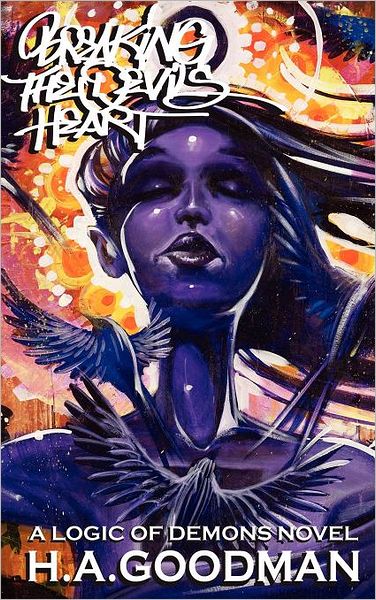 Breaking the Devil’s Heart by H.A. Goodman
Breaking the Devil’s Heart by H.A. Goodman
(a Logic of Demons novel), Outskirts, $18.95, 346pp, hc, 9781432790790. Fantasy.
When Stewart and Layla recruit a demon to spy on the Devil, their decision takes them on whirlwind ride through the afterlife. Journey alongside this young couple in H.A. Goodman’s new novel, Breaking the Devil’s Heart, and join forces with a teenage Angel outcast to bankrupt Satan’s underground Company and save Heaven from civil war. H.A. Goodman’s Breaking the Devil’s Heart is a rollercoaster afterlife experience that tests a young couple’s love, their grasp on reality, and the essence of human nature. What happens when Stewart and Layla tour Hell’s Marketing Department and Stock Exchange? What happens when their relationship is tested by Satan? This book is unlike anything you’ve ever read, or ever thought the afterlife might be like. Breaking the Devil’s Heart is an enlightening look into an alternate world, a new afterlife, and a profound journey inside the human conscience.
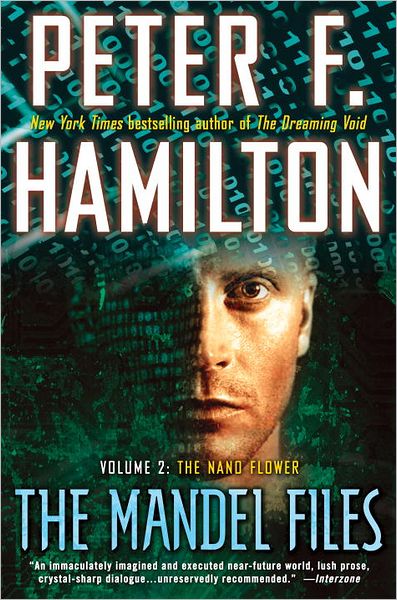 The Mandel Files: Volume 2: The Nano Flower by Peter F. Hamilton
The Mandel Files: Volume 2: The Nano Flower by Peter F. Hamilton
Del Rey, $19.95, 610pp, tp, 9780345533142. Science fiction.
Peter F. Hamilton’s groundbreaking Mandel Files series concludes with The Nano Flower, a tour de force of unbridled imagination and cutting-edge scientific speculation.
Greg Mandel is a psychic detective whose skills have been augmented by powerful but dangerous biotechnology. Those abilities have won him success and almost killed him many times over. Little wonder that he has settled down too the life of a gentleman farmer.
But Greg’s former employer, the mighty tech company Event Horizon, needs him once more. After Royan, hacker-genius and husband to company owner Julia Evans, mysteriously vanishes, a business rival suddenly boasts an incredible new technology. Has Royan been kidnapped and forced to work for his captors, or is the truth far stranger? The answer may lie in a gift of flowers received by Julia—flowers with DNA like nothing on Earth. Greg already has his hands full with corporate killers and other unsavory characters. Is he going to have to add aliens to the list?
The Greg Mandel trilogy—which also includes Mindstar Rising and A Quantum Murder, available in Volume 1—set a new standard for science fiction when it first appeared in the 1990s. The Nano Flower is every bit as gripping today—and even more timely.
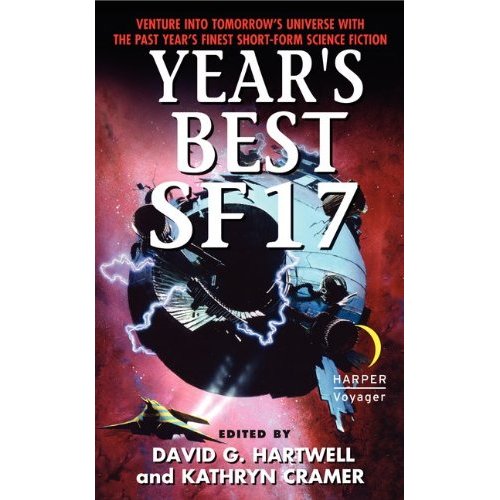 Year’s Best SF 17 edited by David G. Hartwell and Kathryn Cramer
Year’s Best SF 17 edited by David G. Hartwell and Kathryn Cramer
Harper Voyager, $7.99, 490pp, pb, 9780062035875. Science fiction anthology.
The best short form science fiction of 2011, selected by David Hartwell and Kathryn Cramer, two of the most respected editors in the field.
The short story is one of the most vibrant and exciting areas in science fiction today. It is where the hot new authors emerge and where the beloved giants of the field continue to publish.
Now, building on the success of the first fourteen volumes, Eos will once again present a collection of the best stories of 2011 in mass market. Here, selected and compiled by David G. Hartwell and Kathryn Cramer, two of the most respected editors in the field, are stories with visions of tomorrow and yesterday, of the strange and the familiar, of the unknown and the unknowable.
With stories from an all-star team of science fiction authors, The Year’s Best SF 17 is an indispensable guide for every science fiction fan.
[Contributors: Ken MacLeod, Elizabeth Bear, Ken Liu, Mercurio D. Rivera, Nnedi Okorafor, Karl Schroeder, Paul Park, Charlie Jane Anders, Neil Gaiman, Judith Moffett, Gregory Benford, Madeline Ashby, Robert Reed, Karen Heuler, Tony Ballantyne, Bruce Sterling, Pat MacEwen, Michael Swanwick, Gwyneth Jones, Nancy Kress, Genevieve Valentine, Yoon Ha Lee, and Carolyn Ives Gilman.]
 Silver by Rhiannon Held
Silver by Rhiannon Held
Tor, $14.99, 318pp, tp, 9780765330376. Urban fantasy.
In Silver, debut novelist Rhiannon Held makes her mark on the urban fantasy landscape with a compelling, original take on werewolf politics and society in the modern day.
Andrew Dare is a werewolf of the Roanoke pack, whose territory spans most of the East Coast of the United States. As the pack’s enforcer, Andrew is responsible for the security of Roanoke’s borders, and is duty-bound to capture or kill any Were intruders in the pack’s territory. When a lone Were trespasses on Roanoke land, Andrew’s hackles rise—the new Were doesn’t smell or act like anyone he’s ever come across before. Her behavior is erratic, her scent is strange, and for some odd reason, she persists in remaining in her human—not wolf—form.
When Andrew catches the Were who calls herself Silver, the mystery deepens. She’s been tortured—her blood contaminated by liquid silver—and driven mad, and she appears to have lost the ability to shift into her wolf form. Not only that, but Silver claims to be able to see and speak to Death itself. Roanoke’s alpha orders Andrew to return Silver to her home pack immediately, but as the torture that Silver underwent caused her to lose most of her memory, Andrew’s assignment is far from easy.
In Andrew’s search to discover Silver’s true identity and pack of origin, he discovers that whoever was responsible for Silver’s debilitated condition represents a terrible threat to every Were across the country. Though the threat must be stopped as soon as possible, the shifting sands of interpack politics make fighting it a tricky proposition. Andrew and Silver must join forces in order to combat this menace, and in their quest, grow closer to each other and discover their unexpected inner strength.
A gripping, unique urban fantasy debut replete with danger, romance, and intrigue, Silver is an irresistible page-turner that will leave readers eager to learn more about Andrew, Silver, and the ins and outs of author Rhiannon Held’s engrossing depiction of werewolf society.
 Nebula Awards Showcase 2012 edited by James Patrick Kelly and John Kessel
Nebula Awards Showcase 2012 edited by James Patrick Kelly and John Kessel
Pyr, $17.95, 336pp, tp, 9781616146191. Science fiction anthology.
The Nebula Awards Showcase volumes have been published annually since 1966, reprinting the winning and nominated stories in the Nebula Awards, voted on by the members of the Science Fiction and Fantasy Writers of America. The editors selected by SFWA’s anthology committee (chaired by Mike Resnick) are John Kessel and James Patrick Kelly, both highly acclaimed not only for their own award-winning fiction but also as coeditors of three anthologies: Feeling Very Strange: The Slipstream Anthology, Rewired: the Post-Cyberpunk Anthology, and The Secret History of Science Fiction.
Stories and excerpts by Harlan Ellison, Kij Johnson, Christopher Barzak, Eric James Stone, Rachel Swirsky, Geoffrey Landis, Shweta Narayan, Adam-Troy Castro, James Tiptree Jr., Aliette de Bodard, Amal El-Mohtar, Kendall Evans and Samantha Henderson, Howard Hendrix, Ann K. Schwader, Connie Willis, and Terry Pratchett.
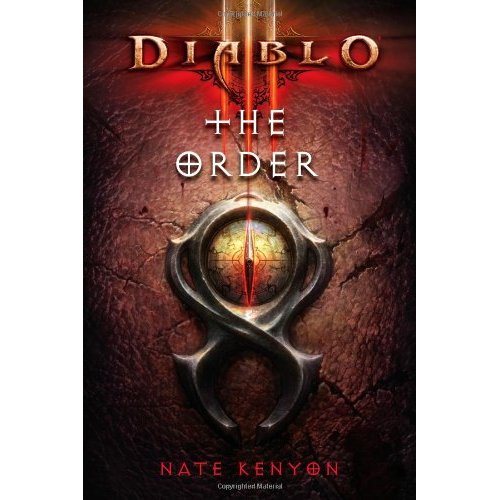 Diablo III: The Order by Nate Kenyon
Diablo III: The Order by Nate Kenyon
Gallery, $26.00, 374pp, hc, 9781416550785. Media tie-in.
Deckard Cain made his way across the floor, following the footprints to an alcove in the far wall. Rotted boards clung to supports, the last remains of an ancient library. This had been a ritual chamber, many centuries before, used to summon things from beyond the human world. A portal to the Burning Hells themselves, perhaps. The shelves were empty now. He saw a speck of yellow underneath a splinter of wood and bent to pick up a corner of parchment paper, curled and speckled with mildew.
Something moved in the shadows to his right.
He whirled, holding the light up. For a moment it appeared as if the shadows themselves were alive, bunching and swirling like ink in water. At the same time, a voice like the distant moan of wind drifted through the empty room and raised the hairs on the back of his neck.
“Deckaaaaarrdddd Caiiinnnn…”
Cain felt a strange doubling, a memory of a night many years before, when he was just a boy. A whispered voice calling to him, just like this. He backed away, fumbling in his rucksack with one hand, holding the lighted staff with the other against the darkness. Already he was doubting himself: had it just been the wind moving through the broken remains of the building above him, a trick his mind had played after so long in the sun?
The voice came again, a sound like bones scraping together in the grave.
“Your ghosts are many, old man, and they are active.”
A grating of metal over rock seemed to come from everywhere at once. Once again a pool of black smoke thickened and then dissipated, only to reassemble somewhere else: a shape carrying a sword, the form of a man, but with eyes that glowed red with the fires of hell.
Cain knew what this was, yanked from the depths of his own mind and used against him: the image of the Dark Wanderer himself, conjured up to weaken his resolve. The smoke-shape swirled and shifted, reforming into two indistinct human shapes, one taller and clearly female, one small and delicate. Shock raced through Cain’s limbs as an older, familiar memory fought to surface. He closed his eyes against the darkness as the yawning pit of despair opened within him, threatening to pull him in.
You must not listen.
 World of Warcraft: Wolfheart by Richard A. Knaak
World of Warcraft: Wolfheart by Richard A. Knaak
Pocket, $8.99, 456pp, pb, 9781451605761. Media tie-in.
In the wake of the Cataclysm, conflict has engulfed every corner of Azeroth. Hungering for more resources amid the turmoil, the Horde has pressed into Ashenvale to feed its burgeoning war machine. There, acting warchief Garrosh Hellscream has employed a brutal new tactic to conquer the region and crush its night elf defenders, a move that will cripple the Alliance’s power throughout Azeroth.
Unaware of the disaster brewing in Ashenvale, the night elves’ legendary leaders, High Priestess Tyrande Whisperwind and Archdruid Malfurion Stormrage, conduct a summit near Darnassus in order to vote the proud worgen of Gilneas into the Alliance. However, resentment of Gilneas and its ruler, Genn Greymane, runs deep in Stormwind’s King Varian Wrynn. His refusal to forgive Genn for closing his nation off from the rest of the world years ago endangers more than just the summit: it threatens to unravel the Alliance itself.
Varian’s animosity is only one of many unsettling developments in Darnassus. An uneasiness creeps over the once-immortal night elves as the first of them fall victim to the infirmities of age. While they cope with their mortality, tensions flare over the reintroduction of the Highborne, formerly the highest caste of night elf nobility, into their society. Many night elves are unable to pardon the Highborne for the destruction unleashed millennia ago by their reckless use of magic.
When a murdered Highborne is discovered on the outskirts of Darnassus, Malfurion and Tyrande move to stop further bloodshed and unrest by appointing one of the night elves’ most cunning and skilled agents to find the killer: the renowned warden Maiev Shadowsong. Yet with all that is transpiring in Darnassus, the Alliance might be powerless to stop the relentless new warchief Garrosh from seizing the whole of Ashenvale.
 Home from the Sea by Mercedes Lackey
Home from the Sea by Mercedes Lackey
(an Elemental Masters novel), DAW, $25.95, 312pp, hc, 9780756407278. Fantasy.
Mari Prothero had grown up on the outskirts of a tiny fishing village on the west coast of Wales. She lived alone with her father, Daffyd, a master fisherman who seemed able to weather any storm, no matter how severe, and still bring his coracle back into port with his nets full. Although the sea had never harmed her father, Mari still worried every time he went out in extreme weather, for Mari’s mother and older brother had been drowned by a rogue wave when Mari was just an infant. Her father was all she had left, and Mari was not blind to the possibility of losing him.
The Protheros’ cottage was far finer than any fisherman’s cottage in the village, and had been in the family for as long as anyone could remember. And the family itself was an old one—dating back to the mythical days before Arthur and Merlin.
But though the Protheros were well established in the village, Mari had always kept to herself. Partly, it was a habit she had learned from her father—it would not be wise to call attention to how much more prosperous the Protheros were than any other fisherman’s family, and Daffyd was very careful to sell half his catch in one of the larger towns down the seacoast before coming home. He was out in every storm, pulling in fish where no other man could, and Daffyd’s fish were always the fattest, the tastiest. But their unusual good fortune was not the only reason for Mari’s reclusive behavior.
For as long as she could remember, Mari had seen things—things that shouldn’t, that couldn’t be real: Tiny manlike creatures that were mischievous and wore only seaweed, and tiny beings that spoke to her kindly but seemed to be made of water. When she was a child, she had asked her father about these creatures, but Daffyd was clearly so upset by these conversations that Mari had given up trying to talk to him. Now, on the eve of her eighteenth birthday, she was convinced that she was going mad.
But Mari was not going mad, and on the morning of her eighteenth birthday, her father finally told her the great secret of the Prothero Luck… and what they must do to keep it. Her mother and brother were not dead after all. But neither were they human.
They were shape-shifters of the sea, the half-human, half-seal people known as the Selch, and they had returned to their watery domain. Since ancient times, the Prothero family had kept a covenant with these magical creatures. In exchange for protection on the water, a member of the Prothero family would take a Selch to marry, only to relinquish their spouse and one of their children to the sea after a brief number of years. Now Mari’s time had come and her father told her that she must abide by her family’s ancient magical compact, or face dire consequences.
However, Mari was a headstrong Edwardian woman, and she did not take kindly to the concept of marrying merely to provide offspring, especially to an uncaring inhuman being who would then steal her child.
But Mari was not without protectors, for the tiny creatures she had seen her whole life, which she now knew were real, counseled her to “bargain” with her mother’s people.
Meanwhile in faraway London, Lord Alderscroft, the head of the Elemental Masters, was aware that a powerful but untrained Water Master on the far coast of Wales was being threatened by some of the Elemental Elder Spirits, and he had dispatched some very unique champions to come to Mari’s aid.…
 Unnatural Issue by Mercedes Lackey
Unnatural Issue by Mercedes Lackey
(an Elemental Masters novel), DAW, $7.99, 374pp, pb, 9780756407261. Fantasy.
Blood magic…
Susanne Whitestone had always lived in Whitestone Manor, her ancestral home in North Yorkshire. But though she was her father’s only child, she had never set eyes on him, for Richard Whitestone lived as a recluse in a sectioned off wing of the manor. Nonetheless Susanne was happy; raised by her father’s warm and loving servants, it suited her to do simple chores, like working on the grounds of the estate and in the dairy. Susanne was an Earth Master, and liked nothing more than to keep the land itself and its animal inhabitants—both mundane and fae—well nourished and thriving. And despite her father’s neglect, Susanne was surprisingly well trained as a mage of the Earth. For the last eleven years, she had had a special friend in the forest—a powerful fae known only as Robin. Susanne, at twenty-one, doubted any mortal Earth Master could find fault with the practices that Robin taught her.
Richard Whitestone was also an Earth Master, but since his beloved wife’s death in childbirth with Susanne, he had lived a kind of half-life. He hated even the thought of the child who had ended his wife’s life. His own life had withered, and his spirit had contracted into a hard, cold thing. As he had grown bitter, twisted, and blighted, so had everything he could see from his windows—his once-beautiful private garden was now as stark and wizened as his heart. But as the years passed, Richard found that there as one thing that gave him solace—the thought, first just a fleeting thing, then later an obsession, that he could bring his Rebecca back to life through the dark practice of necromancy. He would need an appropriate vessel for her spirit, a young woman, preferably one who looked like she did and was approximately the same age that Rebecca had been at the time of her death—twenty-one… and Susanne was the image of her mother.
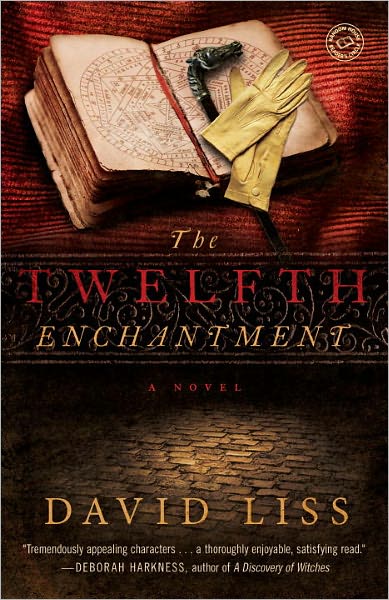 The Twelfth Enchantment by David Liss
The Twelfth Enchantment by David Liss
Ballantine, $15.00, 415pp, tp, 9780345520180. Historical fiction.
Lucy Derrick is a young woman left at the mercy of her unpleasant uncle after her father’s death. Faced with the prospect of a loveless arranged marriage, she is resigned to her fate—until a handsome, stricken man appears on her doorstep, beset by a mystical illness and delivering cryptic instructions. Soon Lucy is entangled in a web of adventure, mystery, scandal, and discovery that includes a fraudulent inheritance, an ancient magical tome, and dark creatures that are determined to shape Lucy’s future for their own purposes.
With the world undergoing an industrial transformation and England on the cusp of revolution, Lucy is drawn into a dangerous conspiracy in which her life and her country’s future hang in the balance. Alongside characters such as Lord Byron (at his rakish, club-footed best), William Blake, and a mysterious Mary Crawford (from the pages of Jane Austen’s Mansfield Park), Lucy must puzzle her way against a host of dark, inexplicable forces. Now available in paperback, The Twelfth Enchantment is a delicious love story, a thrilling magical adventure, and a work of compelling alternate history.
 Ninja Versus Pirate Featuring Zombies by James Marshall
Ninja Versus Pirate Featuring Zombies by James Marshall
ChiZine, $15.95, 240pp, tp, 9781926851587. Fantasy.
Aside from her big breasts, pale blue lips, child-bearing hips, baby-powder-white skin, cotton-candy-pink hair, and the unicorn that follows her everywhere, Baby Doll15 seems like just a regular fifteen-year-old girl
In a world where zombies control banks and governments, only one young man sees the way things are and emerges from the chaos and destruction: Guy Boy Man. While he tries to end human suffering worldwide and in his high school, Guy Boy Man meets a cute pink-haired girl named Baby Doll15 who has a unicorn that follows her everywhere. An epic romance begins, but forces beyond their control are intent on keeping the young couple apart. One of those forces may—or may not be!—Guy Boy Man’s closest friend, a handsome African-American ninja named Sweetie Honey; another could be four exotically beautiful, genetically engineered and behaviourally modified eastern European girls; yet another, the principal of their high school… not to mention an impending standardized test known as the Zombie Acceptance Test! Will Guy Boy Man find a way to be with Baby Doll15 in a world where everyone is doomed to become either zombies or zombie food?!
Ninja Versus Pirate Featuring Zombies is part Napoleon Dynamite, part The Matrix, and all awesome. It’s the first book in the How To End Human Suffering series.
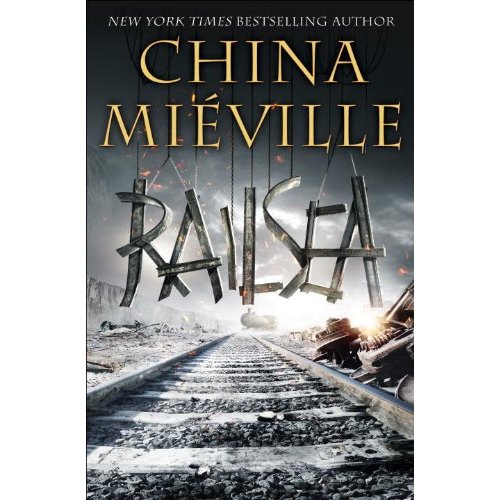 Railsea by China Miéville
Railsea by China Miéville
Del Rey, $18.00, 432pp, hc, 9780345524522. Fantasy.
From China Miéville comes a novel for readers of all ages, a gripping and brilliantly imagined take on Herman Melville’s Moby-Dick that confirms his status as “the most original and talented voice to appear in several years.” (Science Fiction Chronicle)
New York Times bestselling and award-winning author China Miéville doesn’t follow trends, he sets them. Relentlessly pushing his own boundaries as a writer, he succeeds in expanding the boundaries of the entire field. Following his 2011 New York Times bestselling novel, Embassytown, China Miéville delivers Railsea, an adventure story of an impossible journey.
On board the moletrain Medes, Sham Yes ap Soorap watches in awe as he witnesses his first moldywarpe hunt: the giant mole bursting from the earth, the harpoonists targeting their prey, the battle resulting in one’s death and the other’s glory. But no matter how spectacular it is, Sham can’t shake the sense that there is more to life than traveling the endless rails of the railsea—even if his captain can think only of the hunt for the ivory-coloured mole she’s been chasing since it took her arm all those years ago. When they come across a wrecked train, at first it’s a welcome distraction. But what Sham finds in the derelict—a series of pictures hinting at something, somewhere, that should be impossible—leads to considerably more than he’d bargained for. Soon he’s hunted on all sides, by pirates, trainsfolk, monsters and salvage-scrabblers. And it might not be just Sham’s life that’s about to change. It could be the whole of the railsea.
 Byzantium Endures: The First Volume of the Colonel Pyat Quartet by Michael Moorcock, introduction by Alan Wall
Byzantium Endures: The First Volume of the Colonel Pyat Quartet by Michael Moorcock, introduction by Alan Wall
PM Press, $22.00, 400pp, tp, 9781604864915. Fiction.
Meet Maxim Arturovitch Pyatnitski, also known as Pyat. Tsarist rebel, Nazi thug, continental conman, and reactionary counterspy: the dark and dangerous anti-hero of Michael Moorcock’s most controversial work.
Published in 1981 to great critical acclaim—then condemned to the shadows and unavailable in the US for thirty years—Byzantium Endures, the first of the Pyat Quartet, is not a book for the faint-hearted. It’s the story of a cocaine addict, sexual adventurer, and obsessive anti-Semite, whose epic journey from Leningrad to London connects him with scoundrels and heroes from Trotsky to Makhno, and whose career echoes that of the 20th century’s descent into Fascism and total war.
This is Moorcock at his audacious, iconoclastic best: a grand, sweeping overview of the events of the last century, as revealed in the secret journals of modern literature’s most proudly unredeemable outlaw. This authoritative US edition presents the author’s final cut, restoring previously forbidden passages and deleted scenes.
 Pegasus: The Flame of Olympus by Kate O’Hearn
Pegasus: The Flame of Olympus by Kate O’Hearn
Aladdin, $16.99, 386pp, hc, 9781442444096. YA Fantasy.
When Pegasus crashes onto the roof of Emily’s Manhattan apartment, her life changes forever. Emily is thrust in the center of a fierce battle between the Roman gods and a terrifying race of multi-armed stone warriors called Nirads. She must join forces with a thief called Paelen, the goddess Diana, and a boy named Joel to return Pegasus to Olympus and rescue the gods from certain death.
Along the way, they will fight monsters, run from a government agency that is prepared to dissect Pegasus, and even fly above the Manhattan skyline. It is all a quest to save Olympus before the Olympic flame burns out.
A young girl, a winged horse, and a war of epic proportions make for an adventurous start to an exciting new trilogy.
 A Short Stay in Hell by Steven L. Peck
A Short Stay in Hell by Steven L. Peck
Strange Violin, $11.95, 104pp, tp, 9780983748427. Fiction.
As a faithful Mormon, Soren Johansson has always believed he’ll be reunited with his oved ones in an eternal hereafter. Then, he dies. Soren wakes to find himself cast by a God he has never heard of into a Hell whose dimensions he can barely grasp: a vast library he can only escape from by finding the book that contains the story of his life.
In this haunting existential novella, author, philosopher, and ecologist Steven L. Peck explores a subversive vision of eternity, taking the reader on a journey through the afterlife of a world where everything eveyrone believed in turns out to be wrong.
 The Taken: Celestial Blues: Book One by Vicki Pettersson
The Taken: Celestial Blues: Book One by Vicki Pettersson
Harper Voyager, $13.99, 417pp, tp, 9780062064646. Fiction.
Summer is the perfect time to escape into the world of a fun new series and this June William Morrow is excited to publish The Taken: Celestial Blues: Book One, the first book in a breakout new series from New York Times bestselling author Vicki Pettersson. The Taken is a sexy, supernatural noir mystery featuring fallen angel and former P.I. Griffin Shaw (Grif) and spirited, rockabilly reporter Katherine Craig (Kit) who join forces to track down a killer loose in Sin City.
Known for her unique and imaginative world building, Vicki introduces us to the immortal realm of the Everlast, where Centurions—mortals turned angels—are charged with ferrying murdered souls into the afterlife. Grif’s celestial duty is to escort photojournalist, Nicole Rockwell, safely there after she’s killed while investigating a prostitution ring. Yet while assisting Nicole, Grif rebelliously dons flesh. As punishment, his wings are removed, and he’s forced to return to Vegas—where he and his wife were mysteriously murdered fifty years before.
Worse, because of Grif’s actions, Rockwell’s best friend and colleague, Kit, is now destined to die as well. Yet instead of bowing to fate, Kit and Grif make a deal. He’ll help her hunt down Nicole’s killer if she uses her reporter’s skills to aid him in solving his own murder. However, Grif’s vow to protect his mortal partner—and the strong feelings developing between them—is threatened when they begin exposing conspiracies and illegal activities involving some of the highest-ranking businessmen and officials in Vegas. As the investigation turns deadly, the race is on to find the person at the center of it all.
Readers will not want to miss this fresh, genre-bending first in a series that Suspense Magazine calls an “intriguing mix of paranormal, romance and mystery with just enough suspense!”
Pathfinder Tale: City of the Fallen Sky by Tim Pratt
Paizo, $9.99, 384pp, pb, 9781601254184. Fantasy.
Secrets of the Ancients
Once an alchemical researcher with the dark scholars of the Technic League, Alaeron fled their arcane order when his conscience got the better of him, taking with him a few strange devices of unknown function. Now in hiding in a distant city, he’s happy to use his skills creating minor potions and wonders—at least until the back-alley rescue of an adventurer named Jaya lands him in trouble with a powerful crime lord. In order to keep their heads, Alaeron and Jaya must travel across wide seas and steaming jungles in search of a wrecked flying city and the magical artifacts that can buy their freedom. Yet the Technic League hasn’t forgotten Alaeron’s betrayal, and an assassin armed with alien weaponry is hot on their trail…
From Hugo Award winner Tim Pratt comes a new fantastical adventure set in the award-winning world of the Pathfinder Roleplaying Game.
 Survivors by Z.A. Recht
Survivors by Z.A. Recht
Gallery, $15.00, 308pp, tp, 9781451628821. Fiction.
Following the highly acclaimed Plague of the Dead and Thunder and Ashes, Survivors is the third and final installment in Z.A. Recht’s zombie apocalypse series.
The Morningstar Virus was the end of the world. In the wake of the zombie apocalypse, two separate bands of survivors journey across a decimated America, each with the desperate goal of finding the cure for the virulent plague that threatens the existence of humankind—or what’s left of it. Now it’s up to these inheritors of the future to outlive their waking nightmare, anyway they can.
But for these survivors, it is just the beginning.
One ground includes a brilliant virologist; for the other, an immune soldier proves invaluable. Battling infected and marauding raiders at every turn, the teams soon uncover the devious plans of Sawyer, an agent of the Chairman of the Reunited States of America, who believes that Dr. Anna Demilio already has the cure, and he will stop at nothing to find her. Now, with the salvation of the world and their own souls on the line, how far will the survivors go to emerge victorious?
 Disappearing Nightly by Laura Resnick
Disappearing Nightly by Laura Resnick
(an Esther Diamond novel), DAW, $7.99, 386pp, pb, 9780756407667. Fantasy.
“I’m not a heroine; I just play heroines. Also psychotics, orphans, vamps, hookers, and housewives…”
Thus begins the first fantastical misadventure of Esther Diamond, a struggling actress who seems destined to attract supernatural mayhem.
When bizarre magical disappearances disrupt performances in the Big Apple, Esther receives a mysterious wraning not to go on with her off-Broadway show.
Desperate to stay on stage rather than resort to waiting table, Esther turns to her new BFF, Dr. Maximillian Zadok, a 350-year-old mage whose day job is protecting New York from Evil. Determined to get to the bottom of this mystery without losing her job, Esther and Max team up with a conjuring cowboy, a banker with stage aspirations, and a flock of fearless drag queens. Also on the case is Detective Connor Lopez, a sexy cop who has a thing for Esther, but who fears that she and Max may be a bigger problem than the vanishing performers.
Since the show must go on—and the astronomical rent must be paid—Esther, Max, and their friends pursue Evil to its lair in their fearless determination to find the missing performers and restore harmony to the city that never sleeps.
 Blue Remembered Earth by Alastair Reynolds
Blue Remembered Earth by Alastair Reynolds
Ace, $26.95, 505pp, hc, 9780441020713. Science fiction.
With his critically acclaimed Revelation Space novels, Alastair Reynolds confirmed “his place among the leaders of the hard-science space-opera renaissance” (Publishers Weekly). Now a full-time writer, Reynolds’ spent nearly two decades working as an astrophysicist for the European Space Agency, and his books reflect both his professional expertise and his far-reaching visions of the future.
Blue Remembered Earth is the first book in Alastair Reynolds’s new science-fiction epic that traces the generations of one family across more than ten thousand years of future history—out beyond the solar system, into interstellar space and the dawn of galactic society.
One hundred and fifty years from now, Africa has become the world’s dominant technological and economic power. Crime, war, disease, and poverty have been practically eliminated. The Moon and Mars are settled, and colonies stretch all the way out to the edge of the solar system. And Ocular, the largest scientific instrument in history, is about to make an epochal discovery…
Geoffrey Akinya wants only one thing: to be left in peace, so that he can continue his long-running studies into the elephants of the Amboseli basin. But Geoffrey’s family, which controls the vast Akinya business empire, has other plans for him. After the death of his grandmother Eunice—the erstwhile space explorer and entrepreneur—something awkward has come to light on the Moon, so Geoffrey is dispatched there to ensure the family name remains untarnished.
But the secrets that Eunice died with are about to be revealed—secrets that could change everything… or tear this near utopia apart.
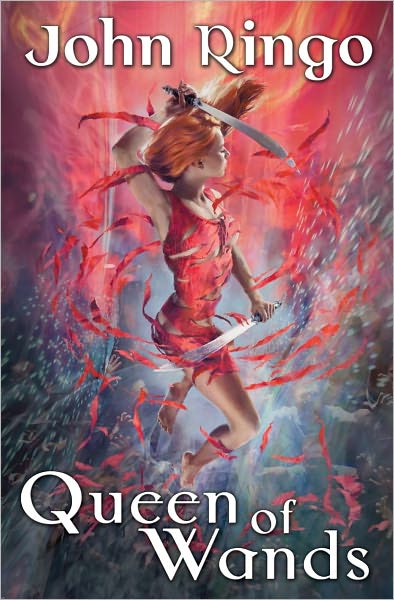 Queen of Wands by John Ringo
Queen of Wands by John Ringo
Baen, $25.00, 352pp, hc, 9781451637892. Fantasy. On-sale date: August 2012.
Soccer mom and demon fighter Barabara Everette is back in this intricately interwoven monster noir thriller, the sequel to bestselling Princess of Wands by eight times New York Times best-seller, John Ringo.
Barbara Everette has a problem. It seems Janea, Barbara’s assistant and The Foundation for Love and Universal Faith’s best operative, has been thrown into a coma by some very nasty magic she’s stirred up. Barbara must track down the perpetrators and break the spell or Janea’s soul will be forever lost on the astral plane. Oh, and if she can’t break the spell, zombies will destroy all mankind.
Meanwhile, Janea, a high-dollar call girl, stripper and High Priestess of Freya when she isn’t fighting demons, must contend with a spiritual journey of her own. It’s a journey into Janea’s acceptance of herself in all her dimensions (and what dimensions they are!). Where to locate one’s true inner essence? At a science fiction convention, of course. But when rescuers pursue Janea into her vision of a geeky alternate reality, we find this is one science fiction convention where the Guest of Honor could turn out to be Death Himself.
Finally, the Christian soccer mom and the Norse priestess stripper face their greatest challenge ever when an ancient Old One rears Her ugly face, and the Mother of Darkness walks among us. Since this is one Mother who is quite immune to any conventional power, including nuclear weapons, it seems humanity’s only hope is God. The question being: Is God willing to save humanity?
Fortunately for the rest of us, Barbara and Janea are determined to fight to the last ounce of faith to find out.
 Further: Beyond the Threshold by Chris Roberson
Further: Beyond the Threshold by Chris Roberson
47North, $14.95, 345pp, tp, 9781612182438. Fiction.
The first in critically acclaimed, Eisner-nominated comic author Chris Roberson’s scintillating new space opera series, Further: Beyond the Threshold is a fascinating ride to the farthest reaches of the imagination.
The thirty-fourth century. Humankind is spread across three thousand light years in a myriad of worlds and habitats known as the Human Entelechy. Linked by a network of wormholes with Earth at its center, it is the world Captain RJ Stone awakens to after a twelve-thousand-year cryogenic suspension.
Stone soon finds himself commanding the maiden voyage of the first spacecraft to break the light speed barrier: the FTL Further. In search of extraterrestrial intelligence, the landing party explores a distant pulsar only to be taken prisoner by the bloodthirsty Iron Mass, a religious sect exiled from the Entelechy millennia before. Now Stone and his crew must escape while they try to solve the riddle of the planet’s network of stone towers… that may be proof of the intelligence they’ve come to find.
 2312 by Kim Stanley Robinson
2312 by Kim Stanley Robinson
Orbit, $25.99, 564pp, hc, 9780316098120. Science fiction.
The year is 231. Scientific and technological advances have opened gateways to an extraordinary future. Earth is no longer humanity’s only home; new habitats have been created throughout the solar system on moons, planets, and in between. But in this year, 2312, a sequence of events will force humanity to confront its past, its present, and its future.
The first event takes place on Mercury, on the city of Terminator, itself a miracle of engineering on an unprecedented scale. It is an unexpected death, but one that might have been foreseen. For Swan Er Hong, it is an event that will change her life. Swan was once a woman who designed worlds. Now she will be led into a plot to destroy them.
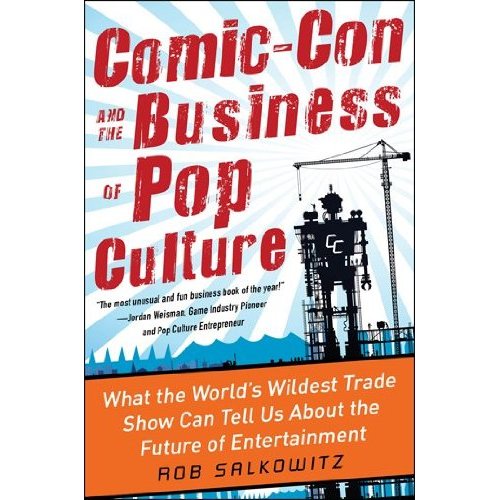 Comic-Con and the Business of Pop Culture by Rob Salkowitz
Comic-Con and the Business of Pop Culture by Rob Salkowitz
McGraw Hill, $27.00, 294pp, hc, 9780071797023. Marketing/Pop Culture.
Mainstream & Underrgound: Comics culture and big business collide in a frenzies mash-up that fortells the futures of global empires
This July, 150,000+ attendees are expected to flood into San Diego’s Comic-Con 2012. Pop culture and mass culture converge here, the modern and the mythical, man and marvel. Events on the convention floor will dominate national headlines, generating unparalleled fan buzz in the worlds of film, games, graphic novels, and celebrity.
the story of “The Con’s” evolution from meek to monster mirrors the legendary transformations of comics’ most beloved superheroes. In 1970, nerdy guys assembled to trade issues and meet the illustrators; over the decades Comic-Con has evolved into a lumbering beast with formidable powers, with tentacles reaching into all forms of media.
Comic-Con and the Business of Pop Culture: What the World’s Wildest Trade Show Can Tell Us about the Future of Entertainment, by business writer Rob Salkowitz offers a rare glimpse inside this pop culture-lover’s convergence of geekdom and big business. “The Con” is a swirling vortex of brands, empires, movie stars, and the undead—clever, crazily, competing for the attentions and spending power of an electrified fan base that meets at a crossroads of genres and interests.
It’s also become a window into the dramatically challenged comics empire. While the onset of digital publishing threatens its very existence, marketers across a wide swath of industries continue to page through the comics backlist for source material. The comics culture, grounded in nostalgia and continuity, is undergoing rapid changes driven by external forces that may render it completely unrecognizable in a short time.
nbsp; Salkowitz, who has been reading comics voraciously since he was a child, offers a first-hand look at:
* How comics went from underground to arbiter of cool;
* The genesis of Comic-Con, launched in the 1960s so a small handful of nerdy guys could trade issues and meet the creators;
* How the event has blossomed from a few hundred in 1970 to 130,000 last year (a million signed up in hopes of attending, but only a fraction were awarded badges through a lottery);
* How comics is a pivotal point of transmedia convergence—with film, TV, books, games (and zombies!) tagging onto it, to lucrative ends;
* The paradox of comics: At its heart, it’s creative, entrepreneurial, and free-spirited, yet it sits squarely at the heart of giant global mega-companies that reaps millions in profits;
* How the industry that got its start selling on magazine racks is now slowly and carefully tip-toeing into the digital age;
* Why Comic-Con is now a national and international phenomenon, with shows in Charlotte, Seattle, Algeria, and Dubai, among dozens of others.
A serious look at the funny business of comics; a detailed, behind-the-scenes look at the trade show floor; the trials and rewards of attending “The Con”; the mainstreaming of comics, from “Persepolis” to Broadway to video games; here are vivid details from the convention floor coupled with a context of the view. Salkowitz speculates on the future of Comic-Con and the survival of the original comic genre, and offers scenarios on where the business is leading itself.
Comic-Con and the Business of Pop Culture offers a fascinating, funny, poignant, fast-clipped look at the future of entertainment—and the beloved comic book—in a swiftly innovating environment moving “faster than a speeding bullet.”
 Conspiracies and Secret Societies: The Complete Dossier, Second Edition by Brad Steiger and Sherry Steiger
Conspiracies and Secret Societies: The Complete Dossier, Second Edition by Brad Steiger and Sherry Steiger
Visible Ink, $24.95, 578pp, tp, 9781578593682. Current Events/History/Social Science.
Startling allegations. Suppressed evidence. Missing witnesses. Assassinations. Cover-ups and threats. Documented connections to even deeper intrigue. Allusions to the New World Order. Too many coincidences to be mere chance? American history is replete with warnings of hidden plots by the Illuminati, the Freemasons, World Bankers, the Secret Government, and extraterrestrial invaders, to name a few.
In this age of minimized individual privacy and maximum government secrecy, the truth sometimes seems a battered relic, more myth than reality, and more valuable for its rarity. Separating fact from fiction, Conspiracies and Secret Societies: The Complete Dossier, Second Edition by Brad Steiger and Sherry Steiger provides gripping details and presents the information without bias.
Shedding light onto the darkest and most enduring stories, Conspiracies and Secret Societies: The Complete Dossier is a compelling encyclopedic overview of over 240 individuals, organizations, and events in which official explanations don’t always mesh with personal testimonials and scientific evidence. The book examines historical topics to more current issues, including:
* Historical riddles—the Ark of the Covenant, the Holy Grail, Noah’s Ark, the Sphinx, alchemy, the true relationship between Jesus and Mary Magdalene, and the churches dedicated to the Black Madonna.
* Classified background on US presidents—from Dwight D. Eisenhower to Barack H. Obama, and their advisors.
* Powerful secret societies and groups—the Knights Templar, Freemasons, Illuminati, the Triads, the Rosicrucians, the Skull and Bones Society, Scientology, the Falun Gong, the New World Order, and Lightning from the East.
* Government cover-ups—electronic spying, the John F. Kennedy and Martin Luther King Jr. assassinations, Area 51, extraterrestrial invaders, black helicopters, satellite snooping, FEMA, the Global Bank, and the Trilateral Commission.
* Terrible secrets—the BP oil spill, Unit 731 and germ experiments, the 2011 tsunami in Japan, and Hurrican Katrina.
* Science mysteries—biochip implants, genetic manipulation, weather control, mad cow disease, AIDS/HIV, West Nile virus, and the bizarre Morgellons disease.
 Lauriat: A Filipino-Chinese Speculative Fiction Anthology edited by Charles A. Tan
Lauriat: A Filipino-Chinese Speculative Fiction Anthology edited by Charles A. Tan
Lethe, $18.00, 234pp, tp, 9781590212547. International Speculative Fiction. On-sale date: 15 August 2012.
Filipinos and Chinese have a rich, vibrant literature when it comes to speculative fiction. But what about the fiction of the Filipino-Chinese, who draw their roots from both cultures? This is what this anthology attempts to answer. Featuring stories that deal with voyeur ghosts, taboo lovers, a town that cannot sleep, the Chinese zodiac, and an exile that finally comes home, Lauriat: A Filipino-Chinese Speculative Fiction Anthology covers a diverse selection of narratives from fresh, Southeast Asian voices.
[Contributors: Andrew Drilon, Erin Chupeco, Kristine Ong Muslim, Isabel Yap, Christine V. Lao, Gabriela Lee, Paolo Chikiamco, Fidelis Tan, Marc Gregory Yu, Yvette Tan, Margaret Kawsek, Crystal Koo, Kenneth Yu, and Douglas Candano.]
 Hidden Things by Doyce Testerman
Hidden Things by Doyce Testerman
Harper Voyager, $14.99, 336pp, tp, 9780062108111. Fantasy. On-sale date: September 2012.
Watch out for the hidden things…
That’s the last thing Calliope Jenkins’s best friend and former lover says to her before ending a 2 a.m. phone call from Iowa, where he’s investigating a case she knows little about. Five hours later, she gets another call, this time from the police. Josh has been found dead, and foul play is suspected. Calliope is stunned.
Especially when Josh leaves a message on her phone a few hours later.
Spurred by grief and suspicion, she heads to Iowa herself, accompanied by a stranger who claims to know something about what happened to Josh and who can—maybe—help Calli get him back.
The road home is not quite the straight shot she imagined. Josh was involved in something a lot more complicated than a teenage runaway or a deadbeat dad, and Calliope finds herself on a surreal road trip into—and behind—America’s heartland, hounded by magical beings twisted by living too long just out of sight, and the secret bogeymen in Calliope’s own troubled past. It’s a search for the truth about her friend’s death and the road she needs to walk if she ever wants to stand on her own. If Calli’s not careful, her worst teenage nightmares could come true: she might never make it out.
 Amped by Daniel H. Wilson
Amped by Daniel H. Wilson
Doubleday, $25.00, 278pp, hc, 9780385535151. Science fiction.
Daniel H. Wilson’s Amped is the riveting new techno-thriller form the New York Times bestselling author of Robopocalypse. Twenty-nine-year-old high school teacher Owen Gray had long ago come to terms with the tiny device in his head, which was implanted to control the seizures he suffered in his youth. It was a necessary, if uneasy, relationship: Owen’s “amp” gave him a normal life, even though he questioned where his brain ended and the computer began. Thousands of “amplified” humans shared the sensation… and yet their devices eradicated learning disabilities, controlled prosthetic limbs, and minimized neurological disorders.
But when the Supreme Court rules that “amplified” humans like Owen are not protected by the same basic laws as pure humans, his world in downtown Pittsburgh instantly fractures. All around him society begins to unravel, and a new class war is on the verge of erupting. before he can get his bearings, Owen receives desperate news from his father, the doctor who originally implanted Owen’s “amp.” He confides a dangerous secret: Owen’s “amp” isn’t what he’s always believed. It has the potential to do something extraordinary—and there are people who will come for him, and want to kill him, for what is in his head. Owen begins a harrowing journey, and all roads lead to a dusty community in rural Oklahoma where he finds the one man who can explain his true abilities. He also meets Lyle Crosby, a dangerous and unpredictable leader of the fast-growing “amp” movement. He is a man whose stunning physical abilities and ruthless ideas show Owen how to harness his own startling gifts—but also threaten to draw him into a dark world from which there may be no moral return.
Amped is a riveting, provocative thriller that showcases Daniel H. Wilson’s wide-ranging talents, featuring the technological expertise and creativity of Robopocalypse, and cutting-edge storytelling reminiscent of Michael Crichton. Amped solidifies Wilson’s fast-growing reputation as a new master.
 Judgment at Proteus by Timothy Zahn
Judgment at Proteus by Timothy Zahn
Tor, $24.99, 416pp, hc, 9780765322135. Science fiction.
Tor Books is proud to release the series finale of Hugo Award winner Timothy Zahn’s star-spanning Quadrail pentalogy, Judgment at Proteus. In a genre where not even the sky is the limit, Zahn creates a wholly unique story from familiar and beloved parts, as the U-T San Diego described it: “Take a to-order craftsman like Timothy Zahn and let him run with a 1930’s concept like a British train-compartment mystery… [then] add in a little of those secret agent/political chappies, [and] put the whole shebang on an interstellar train system run by aliens.” Noir meets sci-fi in the hands of a master—welcome aboard and hold on tight.
The Quadrail that connects the twelve civilization of our galaxy has been the flashpoint of a battle for dominance fought mostly unnoticed by humankind. But Frank Compton of Earth, aided by the enigmatic woman Bayta, has fought on the front lines, using every bit of his human ingenuity and secret agent skills to outwit the Modhri, a group intelligence that would control the minds of every sentient being it can touch.
Following a trail of deception and death to Proteus Station, Compton has discovered a conspiracy that threatens all life in the galaxy: the Shonkla’raa, an ancient enemy thought to be long dead, is rising again. So serious is the danger that the Modhri, the enemy of his enemy, may now be his friend, as the burgeoning threat of a race of invincible soldiers emerges.
If Compton and Bayta can’t stop them, the Shonkla’raa will decimate all who oppose them, destroying the Quadrail and billions of lives throughout the galaxy. Judgment at Proteus moves as fast as the Quadrail itself and Zahn again demonstrates the ingenuity and imagination his fans have long known him for. Enjoyable as a stand-alone novel or as part of the greater saga, Judgment at Proteus is a wild ride not to be missed.